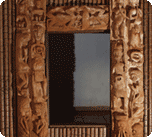 |
 |
 |
| The Baham museum |
 |
 |
 |
 |
| Permanent exhibition |
 Country and history Country and history |
 Secret societies and religion Secret societies and religion |
 Costumes and textile art Costumes and textile art |
 Musical instruments Musical instruments |
 Receptacles and other containers Receptacles and other containers |
 Kings and dignitaries Kings and dignitaries |
 The artists The artists |
 The figures of justice The figures of justice |
 Maternity, fertility and war Maternity, fertility and war |
 Architecture Architecture |
 Itineraries of the collective memory Itineraries of the collective memory |
 |
 |
 |
| Information |
 |
 |
|
The figures of justice
In Baham, the judicial organisation virtually follows the contour of the socio-political and administrative organisation. The different degrees of jurisdiction are as follows, from bottom upwards: the family headed by the father , ta; the lineage or clan headed by the chief tala’ or ta tundye; the quarter or village having at its head the kam pfela’ (head of this unit); the province the head of which is the wala’; the kingdom gung ruled over by the king feu. The people who head a lower degree of jurisdiction submit immediately when a dispute is taken to the level which is hierarchically higher than theirs. Step by step, justice is rendered and the feu decides in the last resort.

Museum of Baham . The figures of justice
Various objects (sculptures, calabashes, stones, etc.) are used during the ceremonies and rites to establish the truth, discover the guilty party and destroy him. The figures of justice come in different forms. Certain specimens are alleged to have occult powers and are considered dangerous. They are specially made to detect witches and the guilty and eliminate them. Last to appear is the judge, thinker or upholder of the law represented by a seated or standing figure, one hand (sometimes both) on his chin or holding a machete. This often decorates pipes, drums, door frames, pillars, pieces of furniture etc.
[ Top page ] |












